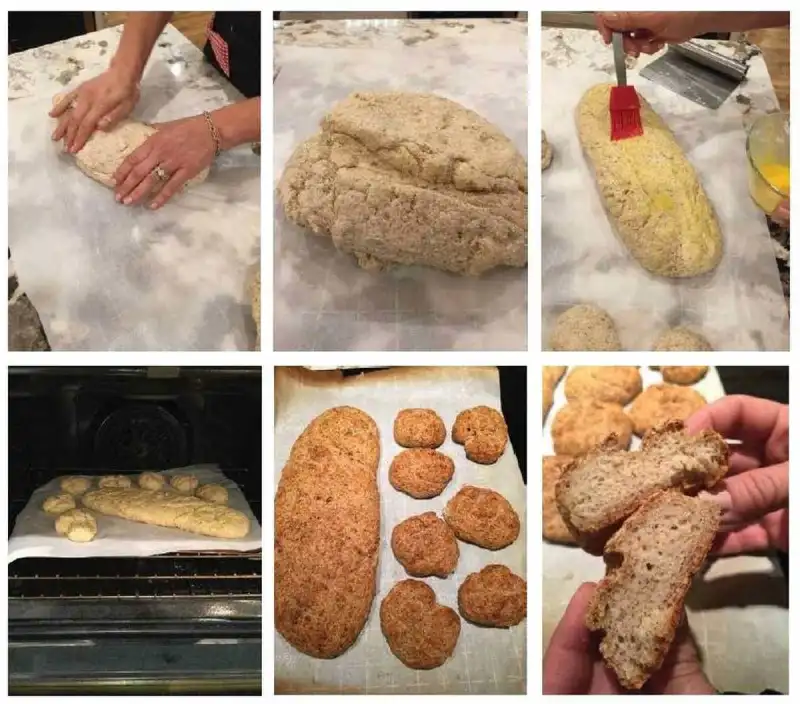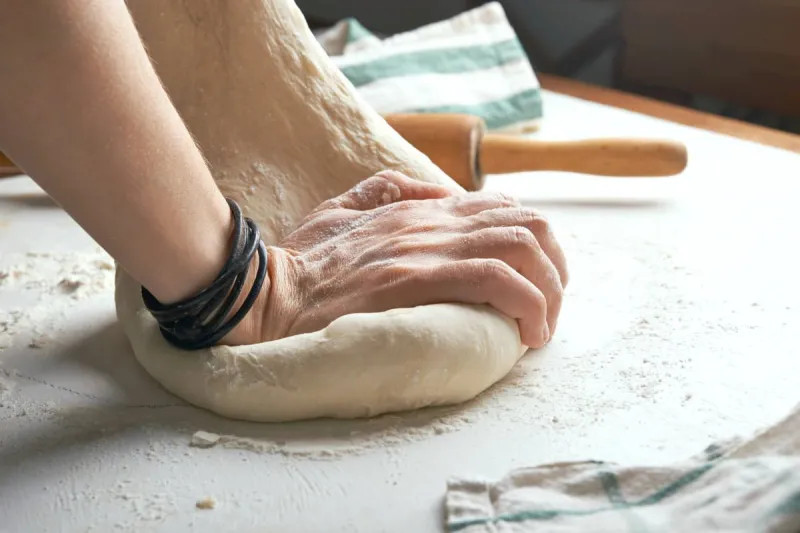Wanting to eat the healthiest bread but don’t know where to buy it or how to make it? Try this healthy bread recipe that’s not only nutritious, but also keto-friendly!
RELATED: Keto Friendly Shortbread Cookies Recipe
The Healthiest Bread Recipe to Try at Home
Ingredients
Dry Ingredients:
- 1 cup almond flour
- 1 cup arrowroot flour
- 1/3 cup coconut flour
- 1 tsp sea salt
- 2 tsp active dry yeast
- 1 ½ Tbsp very finely ground chia seeds
- 2 Tbsp organic psyllium husk powder
Wet Ingredients:
- 1 ¼ cup filtered water
- 2 tsp maple syrup (This is consumed by the yeast, which lowers the glycemic index.)
- 1 egg
The Entire Bread:
- 1550 calories
- 45 g protein
- 185 g carbohydrates
- 70 g fat
- 120 g net carb
Directions

- In a large bowl, whisk together the almond flour, arrowroot flour, coconut flour, and sea salt.
- Heat water at 105-110 °F. Add 2 tsp of maple syrup and stir. Add the yeast and let the mixture stand for 10 minutes. The yeast should bubble or foam. If it doesn’t, start all over again.
- Stir the finely ground chia and psyllium powder into the yeast mixture. Let it stand for 1 minute to thicken, then whisk.
- Pour the thickened yeast-chia mixture into the dry ingredients, and mix with a wooden spoon until thick and fully combined. The dough will be slightly sticky, but workable. Knead for 1 minute.
- Put the kneaded dough back into the bowl. Cover with a damp cloth and place in a warm spot to rise for 1 hour.
- Preheat the oven at 425 °F with a pizza stone (or cooking sheet) inside.
- Divide the dough into two balls. Place one of the dough balls on a square parchment paper or a cutting board. Dip your hands in water and shape the other big dough ball into small round balls. Brush with egg wash, if desired. Use a serrated knife to cut a tic-tac-toe pattern on the top.
- Slide the prepared dough onto the preheated stone or cooking sheet. Bake for 35-40 minutes. Please note that baking time can vary; the measure of doneness is an internal temperature of 205-210 °F.
- Let your baked goodies cool completely on a wire rack. (Not allowing the loaf to fully cool before cutting may result in a gummy interior.) Once completely cooled, slice and serve, or store in an airtight container. To re-crisp crust, toast or reheat at 375 °F for 5-10 minutes.
You can’t call this grain bread or wheat bread because the ingredients do not include grain products like wheat and whole-grain flour. Whole grains, and even refined grains, can cause bloating to people.
This healthy bread recipe is nutritious and safe for you compared with the loaf of bread you’re used to eating. The slices of bread you can have with this recipe make a healthy replacement to your multi-grain bread or whole-wheat bread dishes.
Why Is My Homemade Bread Recipe the Healthiest?

I would not call this type of bread the healthiest without discussing the nutritional information and calories of the ingredients and what health benefits of vitamins and minerals they can provide.
Almond Flour
The first ingredient in my healthiest bread recipe is almond flour. It is a popular gluten-free ingredient and manufacturers make them from ground almonds. A cup of this flour contains the following nutrients:
- Iron (23%)
- Calcium (30%)
- Dietary fiber (56%)
- Potassium (23%)
Fiber is famous for its digestive benefits. It helps normalize bowel movement by enlarging the size and increasing the weight of stool; it also softens it. Grams of fiber allows you to easily release your stool, which lowers your chances of having constipation.
Calcium is the body’s most abundant mineral and is essential for bone health. It primarily aids in building strong bones and maintaining a healthy communication between other body parts and your brain. As you age, your bones weaken, and you need more of this mineral to keep your bones from becoming fragile.
Arrowroot Flour
This flour is also gluten-free. It is a starchy substance from the root of the plant called Maranta arundinacea. One cup of arrowroot flour contains the following nutrients:
- Iron (2.4%)
- Calcium (5.1%)
- Dietary fiber (18%)
- Potassium (14 mg)
- Sodium (2.6 mg)
Iron is an important mineral in the body as your red blood cells contain it. If you can manage your iron levels, you can help your body eliminate fatigue. This nutrient is crucial for boosting hemoglobin, managing anemia, and strengthening the immune system, all of which fight exhaustion.
Hemoglobin Definition: A protein found in red blood cells which transports oxygen throughout the body
Potassium is an essential macro-mineral which aids in managing the electrical activity of the heart and in regulating fluid balance. It is also an electrolyte which is crucial for keeping the body’s acid-base balance. It counteracts the water-retaining effects of sodium, maintaining a normal level of blood pressure.
Coconut Flour
Just like almond and arrowroot flour, coconut flour is also free of gluten and is a good alternative to wheat flour. The flour comes from the plant’s dried flesh (finely ground). Although the recipe only requires 1/3 cup of coconut flour, let me give you a breakdown of the nutrients in a 1/4 cup:
- Potassium (211 mg)
- Sodium (22 mg)
- Fiber (1.7 g)
- Protein (4.35 g)
Sodium is another electrolyte which plays an important role in muscle contraction and enzyme operations. It also helps transmit electrical impulses and regulate fluids in the body.
Heating sodium does not lose its benefits, so you can use it for cooking or baking.
Proteins are one of the components of your cells which help in building and repairing damaged tissues. Your body also needs grams of protein for the production of hormones, enzymes, and other body chemicals. This compound is the building block of your blood, skin, cartilage, muscles, and bones.
Sea Salt
This healthiest bread recipe contains sea salt too. It comes from the evaporation of water in saltwater lakes and oceans. It does not have many nutrients as it is only high in sodium. A teaspoon of it has the following nutrients:
- Sodium (2,325 mg)
- Iron (0.1%)
- Calcium (0.1%)
- Potassium (0.5 mg)
RELATED: Ketogenic Corn Bread
Dry Yeast
Active dry yeast has larger granules than instant yeast, and you need to dissolve it in water prior to using it. Two teaspoons of it contain the following nutrients:
- Iron (1%)
- Calcium (0.2%)
- Protein (3.2 g)
- Fiber (2.2 g)
- Potassium (76 mg)
- Sodium (4 mg)
- Chia Seeds
I also included chia seeds in this healthy bread recipe. They are small black seeds from the Salvia hispanica plant. One tablespoon of these seeds contain the following nutrients:
- Iron (5.1%)
- Calcium (5.8%)
- Vitamin C (0.3%)
- Vitamin A (0.1%)
- Fiber (4.1 g)
- Protein (2 g)
- Potassium (49 mg)
- Sodium (1.9 mg)
Vitamin A is essential in keeping good eyesight and ensuring the proper function of your immune system. It helps convert the light that enters your eyes into an electrical signal that can travel to and be interpreted in your brain. The vitamin also aids in maintaining the natural defenses of your body by strengthening the barriers which can trap bacteria.
Vitamin C, or ascorbic acid, is essential for the growth and repair of torn tissues. It also contributes to wound healing, absorption of iron, and formation of collagen.
The vitamin is also an antioxidant which protects your body from free radical damage.
Organic Psyllium Husk Powder
This powder comes from the seeds of the plant Plantago ovata. Two tablespoons of it have the following nutrients:
- Iron (18%)
- Calcium (2%)
- Protein (5g)
- Fiber (13.8 g)
- Potassium (378 mg)
- Sodium (0.6 mg)
Maple Syrup
This syrup is a type of sweetener or sugar alternative made from extracting the fluid of the maple tree. One tablespoon of it contains the following nutrients:
- Iron (0.1%)
- Calcium (1.6%)
- Potassium (42 mg)
- Sodium (2.4 mg)
Eggs
Eggs are also present in my ingredients for the healthiest bread. They are usually found in various meals, especially during breakfast, because they are nutritious. A large egg, for example, has the following nutrients:
- Iron (4.9%)
- Calcium (2.2%)
- Vitamin A (5.4%)
- Protein (6.3 g)
- Potassium (69 mg)
- Sodium (71 mg)
The Entire Bread:
- 1550 calories
- 45 g protein
- 185 g carbohydrates
- 70 g fat
- 120 g net carb
You need not worry about wrecking your keto diet every time you eat this healthiest bread recipe I made for you. You can pair this real bread up with your other keto-friendly food and supplements. Enjoy eating!
When do you plan to start making this healthiest bread recipe?
Up Next:
- Low Carb Bread Sticks
- Coconut Pecan Fudge Fat Bomb
- Reasons For High Blood Sugars In The Morning
- Keto Success Stories
- Nutella and Peanut Butter Sandwiches
Disclaimer: Our educational content is not meant or intended for medical advice or treatment.
Editor’s Note: This post has been updated for quality and relevancy.








